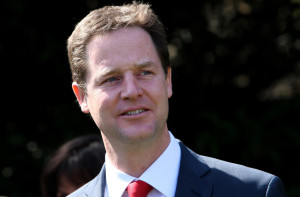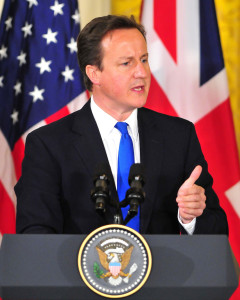Of Rotten Boroughs and Electoral Reform


When the general election held last May in Britain produced a center-right coalition government, the Conservative leader David Cameron offered to his Liberal Democratic counterpart, Nick Clegg, a few compromises to sweeten the deal. These agreements included increased funding for national healthcare, banking reform, and, most importantly for Clegg, provisions for long-overdue electoral reforms.
Since then, political cartoonists have indulged in the array of possibilities to satirize the party leaders. The slightly moonfaced Cameron, with his large forehead and ruddy cheeks, is a caricaturist’s treat. As for Clegg, many a Sunday paper has depicted him as the doormat of the coalition, especially following Parliament’s vote last November to raise university tuition fees, in direct contradiction to the Liberal Democrats’ pre-election pledge opposing any such increase.
Clegg’s treatment may become even harsher in the coming months, if he loses the Liberal Democrats’ most sacred cause: the referendum on electoral reform.
Enacted on February 16th, the Parliamentary Voting System and Constituency Act 2011 proposes to change the General Election voting system to the Alternative Vote, and reduce the size of the House of Commons from 650 to 600. The latter would thereby result in the redrawing of parliamentary constituencies to ensure there would be less than five percent deviation on the electoral quota of the electorate in each constituency. Having received the royal assent on the 16th, the Act now awaits the referendum to be held on May 5th to decide whether or not it will be implemented.
Under the current voting system that dates back to the seventeenth century, the Westminster elections use the First-Past-the-Post (FPTP), in which candidates who win the most votes in a constituency is elected as the Member of Parliament. With FPTP, a candidate may win even if he or she did not win the majority. For example, consider a constituency of 100 voters with three candidates, A, B, and C. If A wins 40 votes, B 35, and C 25, then A is elected – despite the fact that 60% of the constituency did not vote for A. Many voters are aware that their votes within this system will be wasted if they do not vote for who they perceive to be a popular candidate. As a result, they tend to resort to “tactical voting,” discouraging them from voting for a smaller party. Moreover, the current system also encourages people to vote against a candidate rather than for a candidate, which further distorts the election results.
The Liberal Democrats, traditionally derided as “the other party,” have suffered the most from FPTP and thus have campaigned for the Single Transferable Vote (STV), a proportional representation ballot. When the 2010 elections failed to produce a single majority, with the Conservatives just 20 seats short of the 326 threshold, Cameron offered Clegg a referendum on the Alternative Vote system (AV) as a part of the coalition deal.
With AV, voters can rank candidates in order of preference instead of voting for a single candidate. The voters’ first preferences are counted as in FPTP, but if no candidate wins a majority, then the second preference of the candidate who won the least votes is distributed until there is a winner. In the example above, candidate C would drop out and the second preferences of the people who voted for C would be distributed amongst A and B. If 20 of the 25 people who voted for C listed B as their second preference, with the remaining 5 listing A, then A would emerge with 45 votes and B with 55 votes, making B the winner.
The AV referendum is a bittersweet compromise for the Liberal Democrats, particularly because AV is not proportional representation. And although AV is employed by a variety of electoral bodies, most notably the Australian House of Representatives, the proposed system differs from its Australian counterpart in that it does not make listing preferences compulsory. This could further skewer the election results, perhaps even more so than FPTP.
For Clegg, however, some change is better than no change at all. And his political career may also depend on the referendum, as more Liberal Democrat MPs become fed-up with Clegg’s willingness to compromise with the Tories. The proposed rise in tuition fees, which could see universities charging students three times as much as they do now, has already made Clegg a target of intense criticism amongst Lib Dem backbenchers and students alike.
The referendum also puts Cameron in a delicate position. The Tory MPs oppose AV, because it would decrease their share of seats and may forever hinder them from governing independently. But Cameron does not want to campaign against it too visibly because he does not want to appear directly responsible for the AV defeat should his coalition partner lose the referendum. In addition, as Hendrik Hertzberg noted in the New Yorker, the popular rhetoric among the “No to AV” campaigners is that AV encourages formation of coalition governments, which are unstable and inefficient. And Cameron rightly feels uneasy about backing such an argument.
On the other end of the political spectrum, the Labour party has attempted to destroy the legislation through endless filibustering in the House of Lords. Although the Labour leader, Ed Miliband, has publicly expressed his support for the bill, many Labour MPs oppose it. They hope that sabotaging the bill would also sabotage the coalition; as if to justify this effort, Labour Lords grumble about the supposed Tory gerrymandering. They sigh about the return of the rotten boroughs, comparing the constituency remapping to the pre-1832 practice of allowing depopulated constituencies of as little as 50 voters to send the same number of MPs to the House of Commons as a city of tens of thousands.
Not quite. Although the Liberal Democrats stand to gain the most from AV, Labour stands to lose more if it does not pass. If the number of seats in the Commons were reduced without AV, then this would negatively affect Labour more than any other party. In fact, if the 2010 general elections used AV, Labour would have won 264 seats, as opposed to the 258 they won under FPTP.
Of course, AV does not guarantee rosy prospects. As its critics point out, not only is it not proportional representation, but it can also produce winners that no one wanted. By virtue of its design, it tends to favor candidates that most people have lukewarm feelings about rather than candidates that fewer people strongly want to endorse. Drawing upon the 100-people constituency example above, AV would pick a candidate with 51 second-preference votes instead of a candidate with 50 first-preference votes.
However, the shift to a more consensual voting seems a small price to pay to curb the emerging trend in Westminster of encouraging an American style left-right hostility. FPTP promotes an either-or thinking in politics, with little provision for cooperation between Labour and the Conservatives. AV would force both the left and the right to lean towards the center, because they would most likely have to court the Lib Dems to form a majority. Yes, watching an insult-laden Prime Minister’s Questions (PMQs) on Wednesday afternoons may be fun, but it gives little testament to the nation’s bipartisanship when the opposition leader likens the Chancellor of the Exchequer to a “poisonous fungus.”
Labour MPs look set to go to extraordinary lengths to kill the electoral reform—the House of Lords had sloughed through all-night debates on the legislation, most of them over trivial details— but this is not the time to bicker over party politics. Britain needs an electoral reform, and if this opportunity is wasted, the next one may not come for generations.